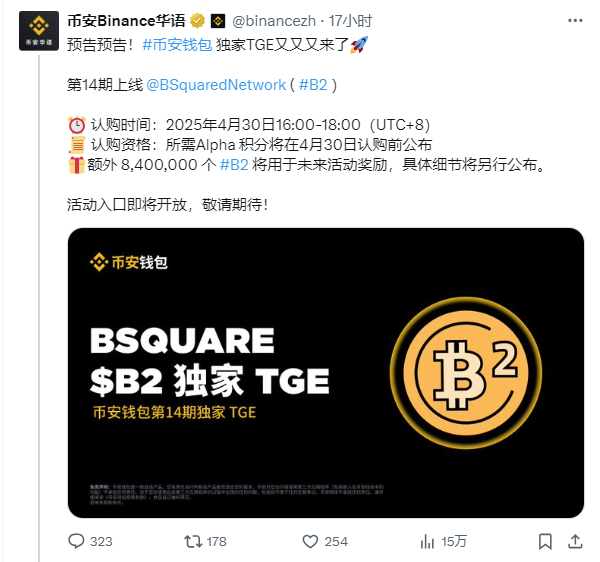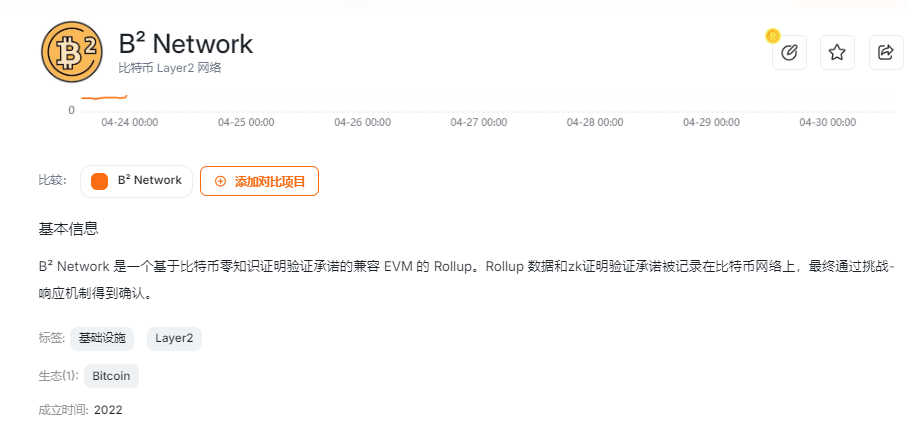Activity Content Analysis

On April 30, 2025, Binance Wallet will host its 14th exclusive Token Generation Event (TGE), launching the Bitcoin Layer 2 star project B² Network (B2). The subscription time is from 16:00-18:00 UTC+8, with participants needing to meet the 82 Alpha points threshold and ensure sufficient BNB balance in their wallet to handle network congestion. After the event, 8.4 million B2 tokens will be used for future ecological incentives, further promoting community participation and ecosystem development.
As a Bitcoin Layer 2 project heavily supported by Binance Wallet, B² Network's TGE is not only a milestone of its mainnet's one-year anniversary but also a symbolic event of Bitcoin ecosystem's leap towards high scalability and low-cost application scenarios. This article will analyze the project from multiple dimensions including technical architecture, innovative value, team background, and market potential.
B² Network: A Breakthrough in Bitcoin Layer 2
1. Project Positioning and Core Objectives

B² Network is a Bitcoin Layer 2 solution based on ZK-Rollup technology, compatible with EVM (Ethereum Virtual Machine), aiming to address three core pain points of the Bitcoin mainnet: slow transaction speed, high costs, and lack of smart contract functionality. By combining off-chain computation and on-chain verification, B² Network increases Bitcoin's throughput by 300 times, reduces transaction costs by 50 times, and introduces smart contract support, unlocking innovative scenarios such as DeFi, Non-Fungible Token, and BTC derivative assets.
2. Technical Architecture: Dual-Layer Design + Hybrid Verification Mechanism
B² Network's technical architecture consists of a Rollup execution layer and a Data Availability (DA) layer, introducing a unique hybrid verification mechanism:
- Rollup Layer: Utilizing ZK-Rollup technology, processing user transactions and generating zero-knowledge proofs through zkEVM for efficient off-chain computation.
- DA Layer (B² Hub): Borrowing Celestia's data sampling and erasure coding techniques, ensuring rapid data distribution to distributed nodes and anchoring data indexes and hashes to the Bitcoin mainnet (via Taproot script). This design avoids Bitcoin block space limitations while guaranteeing data immutability through on-chain anchoring.
- Hybrid Verification Mechanism: Verifying ZK proof integrity off-chain, and performing final confirmation on-chain through a BitVM-style challenge-response protocol, forming a "one-challenge, network-wide consensus" security model.
3. Product Matrix and Ecosystem Layout
B² Network has built a full-stack product covering developers and users:
- Buzz: User incentive program, earning B2 tokens by participating in ecosystem DApps.
- Hive: BTC staking protocol, allowing users to stake BTC for B2 rewards while providing network security.
- Honey: Revenue enhancement tool for B2 holders, supporting liquidity mining and governance voting.
- Cross-chain Bridge: Supporting seamless asset migration of BTC, ETH, USDT to B² Network, compatible with mainstream wallets like MetaMask and UniSat.
In terms of ecosystem collaboration, B² Network has deeply integrated with top projects like UniRouter (a liquid staking protocol with over $24 million TVL), Particle Network (account abstraction solution), and AltLayer (RaaS service provider). Additionally, its testnet phase has attracted over 8 million independent addresses, with cross-chain TVL exceeding $300 million.
(Translation continues in the same manner for the rest of the text)Referencing Merlin Chain, with a total supply of 210 million tokens, the initial market value of B2 could reach $200-300 million, with a corresponding price range of $1-1.5. In the long term, if its TVL breaks through $1 billion and captures 20% of the Bitcoin Layer 2 market share, the market value could potentially reach $1 billion.
Risks and Challenges
- Technical Risks: ZK-Rollup still faces verification delay issues when interacting with Bitcoin, requiring continuous optimization of proof generation efficiency.
- Intensifying Competition: Similar projects like Satoshi VM and Bitlayer may divert ecosystem developers.
- Regulatory Uncertainty: The US SEC's review of BTC derivative financial products may impact market sentiment.
Conclusion
B² Network's TGE marks a new phase for Bitcoin Layer 2, transitioning from "functional exploration" to "large-scale application". Its technical architecture finds a balance between security, compatibility, and cost efficiency. With dual support from capital and ecosystem, it becomes the core infrastructure for Bitcoin DeFi's potential explosion. Despite inevitable short-term market fluctuations, B² Network is poised to replicate Ethereum Layer 2's successful path and become a key hub for value capture in the Bitcoin ecosystem.





